Affordable 27 Inch Penny Boards for Skateboarders


Intro
The world of skateboarding is a colorful blend of freedom, creativity, and youth. Among the many choices available, the 27-inch penny board stands out for its portability and ease of use. Whether you’re a seasoned pro or a greenhorn looking for a bit of thrill, this guide is here to unravel the value of these budget-friendly boards. Not only does it delve into affordable options, but it also closely examines the features and potential drawbacks, ensuring you, the skateboarder, know what you’re getting into before making a leap into the vibrant skateboarding scene.
Skateboarding isn’t just a pastime; it’s a culture, a way of expressing one's self while gliding through streets and parks. From the initial unsteady pushes of a beginner to the intricate tricks of advanced riders, understanding the implications of opting for a 27-inch penny board can help balance affordability with high performance.
In the pages to come, we'll unearth details that every rider from all walks of life should consider. So, let’s embark on this journey to discover just what makes a 27-inch penny board a pragmatic choice for those keen on rolling their way through life.
Skateboarding Techniques
Mastering the Basics
Once you've got your new penny board, the first step is mastering the basics. Balancing, pushing off, and carving turns are the foundational skills every skateboarding enthusiast must master before the adrenaline kicks in fully. To make it easier, start by finding a smooth surface, away from bustling crowds.
Key Techniques to Practice:
- Balancing: Stand on the board with feet shoulder-width apart, knees slightly bent. Practice standing still without wobbling.
- Pushing Off: Once you’re comfortable, practice pushing off with one foot while the other stays on the board. Remember to switch your stance if you feel more comfortable riding with your other foot forward.
- Turning: To turn, lean your body in the direction you want to go, shifting your weight to your toes or heels.
Advanced Tricks and Stunts
After honing your basic skills, the next logical step is to explore tricks and stunts that can impress your friends or even catch the eye of onlookers. Tricks can elevate your skating experience, opening the door to creativity.
Popular Tricks to Master:
- Ollie: A fundamental trick that involves popping the tail of the board while dragging your back foot upwards. This allows the board to leap off the ground.
- Kickflip: Similar to the ollie but with an added spin of the board using your front foot.
- Grinds: These involve sliding on a rail or ledge with the trucks of the board. It’s a staple move that screams style.
"Practicing your tricks on a 27-inch penny board can be liberating, it’s small enough to maneuver and learn quickly, yet sturdy enough to withstand some bumps along the way."
Gear and Equipment
Skateboard Types and Features
When it comes to choosing your new ride, not all skateboards are created equal. The 27-inch penny board has distinctive features that set it apart from traditional skateboards. They are typically made from durable plastic, offering a lightweight feel, which makes them perfect for transport. Also, the wider deck allows for a more stable ride, even for beginners.
Important Features of Penny Boards:
- Material: Plastic construction is common, allowing for flexibility and a lightweight design.
- Wheels: Usually made from softer materials which provide better grip and a smoother ride on rough surfaces.
- Designs: Comes in various colors and patterns appealing to a broad audience.
Essential Safety Gear
To truly enjoy skateboarding without a hitch, investing in safety gear is non-negotiable. Protect yourself from potential falls and mishaps by gearing up with the necessary safety items.
Safety Gear Recommendations:
- Helmet: A must-have for protecting your head during falls. Look for well-ventilated and certified options.
- Knee and Elbow Pads: Essential for cushioning impacts. Choose ones that fit snugly but aren’t cumbersome to wear.
- Wrist Guards: Helpful for preventing wrist injuries when taking a spill.
As skateboarding progresses, the need for safety remains pertinent, especially with the growing popularity among young riders. Earning your stripes on a penny board can open doors to exhilarating experiences, but doing it safely is what truly counts.
Understanding Penny Boards
Understanding penny boards is crucial for anyone delving into the world of skateboarding, especially for those considering a purchase. Penny boards, with their distinct plastic construction and compact size, offer a unique riding experience compared to traditional skateboards. They are often light, portable, and stylish, making them an alluring choice for riders of all ages. By grasping their characteristics and benefits, buyers can better navigate their options and find the right board that suits their needs without burning a hole in their pocket.
Definition and Characteristics
A penny board is essentially a shorter skateboard, typically featuring a length of around 27 inches. This compact size makes it exceptionally maneuverable, ideal for weaving through crowded areas or tight spaces. The board is usually constructed from a high-grade plastic, which gives it both flexibility and resilience.
Key characteristics of penny boards include:
- Material: Most penny boards use an injection-molded plastic that is designed to withstand regular wear and tear. This material helps keep the board light yet sturdy.
- Wheels: Usually made of softer urethane, the wheels are designed to provide a smoother ride across various surfaces.
- Deck Shape: The unique shape of the board, often featuring a slight concave, allows for improved grip and control.
- Portability: The light weight and small size mean that these boards are easy to carry under one’s arm or throw into a bag.
Penny boards capture the essence of skate culture with their vibrant colors and designs, making them attractive to the younger crowd and visually appealing. Whether zipping down a city street or cruising along a beach promenade, penny boards deliver a playful ride.
Popular Size: The Inch Model
The 27-inch model stands out as the most recognized size within the penny board family. Its dimensions strike a balance, providing ample space for foot placement without compromising on portability. This makes it an excellent choice for both beginners and experienced riders.


Some benefits of the 27-inch model include:
- Easier for Beginners: The shorter length can be less intimidating for new riders, allowing for easier balance and navigating skills to develop.
- Great for Short Distances: Ideal for quick trips around town or campus, the board excels in urban settings where public transportation is part of the routine.
- Stability: While it is shorter compared to traditional skateboards, the 27-inch penny board’s wheel base allows for surprisingly good stability, especially for casual riding.
In summary, understanding penny boards, particularly the 27-inch model, equips riders with the knowledge necessary to make informed choices. It is a blend of functionality and style that resonates with many skaters, emphasizing the need for careful consideration when selecting a board that meets personal riding needs.
The Appeal of Cheap Penny Boards
The world of skateboarding is vast, with a myriad of boards to choose from. One type that has gained traction among newcomers and seasoned riders alike is the penny board, particularly the affordable 27-inch model. The appeal of cheap penny boards is rooted in their accessibility, practicality, and the way they cater to diverse riding styles and preferences. Understanding this appeal is pivotal for anyone considering a budget-friendly option.
Affordability and Accessibility
When it comes to penny boards, their price tag is often one of the first things that catch the eye. For many, trying out skateboarding can seem daunting—both in terms of skill and financial commitment. This is where cheap penny boards shine. With prices that typically hover in the lower range of skateboards, they make the sport easier to access.
A major benefit of opting for a less expensive model is that it allows beginners to dip their toes into the skateboarding pool without worrying about making a huge financial mistake. For instance, rather than splurging on a high-end board, a first-time rider can purchase a 27-inch penny board, which often costs less than 100 dollars. This affordability gives new riders the chance to experiment and gain confidence without being overly invested.
However, the appeal doesn't just end at the cash factor. These boards are also lightweight and portable, making them easy to carry around, perfect for urban commuters. This portability can transform the commute, as many riders can simply toss their boards under their arms while heading to class or work.
"A penny board is like a passport to urban adventures. Easy on the wallet and a breeze to carry, it opens doors to spontaneity even on tight schedules."
Target Demographics
So, who exactly are these budget-friendly penny boards for? You might be surprised to find that the target demographics are quite varied. First and foremost, you have the new riders, those curious individuals wanting to give skateboarding a go, fueled by the need for quick and easy mobility around town.
Then, there are parents looking for the perfect starter board for their children. A 27-inch penny board is often just the right size for younger skaters; it fits well with their smaller stature and demands less physical effort to maneuver. Such boards allow kids to learn balance and coordination, all while having fun.
Additionally, college students and young professionals make up a significant portion of the market. These individuals typically seek a practical solution for getting around campus or the city, where parking can be a pain. Cheap penny boards offer a nimble alternative to bicycles and scooters, aligning perfectly with the lifestyle of those constantly on the move.
Factors to Consider When Choosing a Cheap Penny Board
Choosing a penny board, especially of the budget variety, is more intricate than many may assume. While the allure of a low price tag may entice potential buyers, several factors must come into play when making that final decision. Think of it as a balancing act; weighing price against quality, design, and performance can be the difference between a satisfying ride and a frustrating experience. This section dives into the essential aspects that skateboard enthusiasts—both newbies and seasoned pros—should contemplate before settling on a cheaper model.
Material Quality and Durability
When it comes to penny boards, the materials used mainly dictate durability and longevity. Most cheap models often skimp on quality to save costs, leading to boards that can crumble faster than a cookie in a toddler's hand.
- Polypropylene vs. Plastic: Many affordable boards utilize polypropylene foam which is lighter and offers more flexibility. However, be wary of boards made from subpar plastic, as they tend to warp under stress or heat.
- Trucks and Wheels: The hardware needs attention too. Ideally, you want to ensure the trucks are made from sturdy metals like aluminum and that the wheels are not flimsy. Cheaper models often cut corners, leading to rapid degradation of both wheels and trucks.
Evaluating these material qualities upfront can greatly enhance your riding experience and extend the life of your board. As the saying goes, you get what you pay for—this is especially true when it comes to the material quality of penny boards.
Design and Aesthetic Choices
Next up is design, which isn’t just about how the board looks but also how it feels. A well-designed penny board will cater to both functionality and visual appeal. Novices often overlook this aspect while seasoned riders tend to have strong opinions.
- Colors and Patterns: The most attractive boards can incite a sense of identity among riders. Whether you prefer classic black or vibrant neon hues, these aesthetic choices often speak volumes about the rider's personality.
- Shape and Foot Placement: The design should also lend itself to comfort while riding. Ensure that the shape allows for secure foot placement. Often, budget boards will have less ergonomic designs that don't support a comfortable stance.
With markets flooded with options, finding a board that aligns with both your style and functional needs becomes crucial. Remember, you’ll be spending time skating on this, so it better look cool and feel comfy!
Weight Capacity and Performance
Lastly, one of the most critical factors often gets glossed over: weight capacity and performance. Before you buy, be honest about the rider's weight and how aggressively you or the intended user plan to ride.
- Rider Weight Limits: Many inexpensive boards have a lower weight limit, which can affect performance and safety. Make sure to check the specifications. An overloaded board not only wears out quicker but might also crack under pressure.
- Smoothness of Ride: Ultimately, the performance of a penny board is about how well it glides and how well it responds to maneuvers. Cheaper boards often compromise on wheel quality, leading to a bumpy experience. Repeated irritation can diminish one's enthusiasm to ride, so scrutinizing this element beforehand is key.
In summary, a penny board might seem straightforward at first glance, but multiple factors contribute to the overall riding experience. Focusing on material quality, design, and performance features creates a roadmap for selecting a reliable budget-friendly board. Sustainable choices mean gearing up for a better riding adventure, helping you glide smoothly across the pavement, even if your wallet feels a bit lighter.
Comparing Brands: A Look at Affordable Options
When venturing into the world of 27-inch penny boards, the choices can be overwhelming. With numerous brands vying for attention, it’s essential to grasp the nuances that distinguish them. Evaluating various brands can illuminate their strengths and weaknesses, helping you to align your choice with your riding style, preferences, and budget restrictions. This section of the article emphasizes the significance of comparing brands in the context of affordability and performance in penny boards.
Not only does understanding the key players in the market assist in smart purchasing decisions, but it also fosters a deeper appreciation for the craft behind skateboard manufacturing. By delving into the options available, riders can uncover which brands deliver on promises of performance without breaking the bank.
In the realm of budget-friendly skateboarding, some brands stand out for their commitment to balance quality and cost, shaping the experiences of countless riders.
Top Brands in the Budget Segment


Several brands cater specifically to the low-cost segment in the penny board market. Here are the most notable:
- Penny Australia: The originator of the penny board craze, they offer a range of styles and designs that appeal to both beginners and seasoned riders alike. Their models, while not the cheapest, are still relatively affordable and promise reliability.
- Rimable: Known for their affordability, Rimable offers a colorful selection of 27-inch boards that deliver decent performance for newcomers.
- White Fang: This brand has carved out a niche in the budget-friendly category, known for boards that boast good durability and a variety of eye-catching designs.
- Slick: Offering a unique line of skateboards that emphasize style, Slick boards are produced with a focus on affordability without forsaking quality.
These brands provide a range of price points and designs, each with its own unique selling propositions.
Pros and Cons of Each Brand
While all these brands have their strengths, it’s equally important to be aware of their drawbacks. This understanding will play a significant role in ensuring that your wallet doesn’t take a hit and that your riding experience meets your expectations.
Penny Australia
Pros:
- High-quality materials that offer good durability
- Variety of designs available
- Resale value tends to be higher
Cons: - Prices can be on the higher side for budget-conscious buyers
Rimable
Pros:
- Extremely affordable, ideal for beginners
- Lightweight and easy to carry
- Variety of designs and colors
Cons: - Durability may be an issue with heavy use
- Lesser brand reputation compared to others
White Fang
Pros:
- Offers solid performance for a mid-range board
- Stylish designs that appeal to younger audiences
Cons: - Slightly heavier than some competitors
- Limited advanced features
Slick
Pros:
- Unique and vibrant style
- Generally good quality for the price
Cons: - Availability may vary by region
- Not as widely recognized as Penny Australia
An informed choice involves weighing the pros and cons of each brand based on your personal preferences and riding needs, ensuring you get bang for your buck.
Performance Insights of Budget-Friendly Models
When venturing into the world of penny boards, especially the 27-inch models, understanding their performance characteristics becomes imperative for any skater or enthusiast. These insights not only illuminate the nuances of riding experience but also spotlight stability and control that any budget-friendly option can offer. Now, let’s dig into what makes these boards tick and why performance matters, especially when it comes to making economical choices.
Riding Experience
The riding experience on a 27-inch penny board can be a mixed bag, often determined by the quality of materials used in manufacturing as well as the specific design features of each model. Riders typically expect flexibility and agility when riding, key attributes that contribute to an enjoyable experience on a shorter board.
- Maneuverability: A board’s ability to pivot and turn swiftly is crucial, especially in urban settings where avoiding obstacles can be a daily challenge. Cheaper models might sacrifice this maneuverability in favor of lower production costs, which could lead to clunky rides.
- Comfort: The shape and grip of the deck can significantly affect comfort during rides. Models with a well-designed grip tape, like those from brands such as Penny Australia, provide better footing and confidence while performing tricks or cruising down the street.
- Speed Control: Riders need to be aware that not all budget-friendly boards support high-speed ventures. While some riders prefer a relaxed cruise, others seek the thrill of zipping through the streets. It’s essential to find a model that suits these expectations without compromising safety.
Overall, the joy of riding these boards comes from the combination of design and user experience; skaters tend to compare the feel of one board to another as they explore various models available on the market.
Stability and Control
Stability is a non-negotiable feature when considering any board. Inexpensive options can sometimes be a gamble in this regard; however, the right construction can yield surprisingly stable rides. Stability and control are especially vital for newer riders or those who may not have perfected their balance yet.
- Wheel Quality: The hardness and material of the wheels significantly affect how stable a board feels. Softer wheels can navigate potholes and imperfections in the road better, providing a smoother ride and minimizing the chances of wiping out. Budget boards equipped with quality wheels can provide the stability many seek without breaking the bank.
- Base Design: A wider base allows for a more stable stance, giving riders ample control when navigating different terrains. Trimming down to a 27-inch model may seem counterintuitive, but when properly designed, it can maintain or even enhance stability compared to longer boards.
- Bearing Quality: Quality bearings ensure a smooth ride, allowing for easy roll and less friction. Budget-friendly boards with decent bearings can easily compete with pricier options, delivering a desirable blend of stability and performance.
"Not all that glitters is gold, and not all penny boards are created equal. Choose wisely to enhance your riding experience!"
For additional detailed reading on riding experiences or stability in skateboarding, one might find valuable discussions on relevant forums or articles from sources like Wikipedia or Britannica.
Whether you're a beginner or a seasoned pro, ensuring that your chosen board aligns well with your performance expectations will always pay off in the long run.
Safety Considerations for Inexpensive Boards
When it comes to selecting a penny board, especially when navigating the lower end of the price spectrum, safety should be a top-of-mind concern. While affordability is an attractive quality, it is essential to ensure that the board meets certain safety standards to protect the rider. Cheaper models may often compromise on various safety features, making it imperative for consumers to understand what to look for. Selecting a safe board not only enhances the riding experience but also minimizes the risk of accidents, inviting comfort and confidence while riding.
Evaluating Safety Features
One of the first steps to gauge safety in budget penny boards is by assessing their construction and design elements. Here are some critical features to consider:
- Material Quality: The board should be constructed from durable materials, like high-quality plastic or composite materials. Those that rely on cheaper alternatives might break or warp easily, leading to dangerous falls.
- Grip Tape: A good board will feature a reliable grip tape, ensuring that your feet stay planted securely while riding. Poor-quality grip tape can wear out quickly or lose its effectiveness, presenting a slipping hazard.
- Wheels and Trucks: The wheels should ideally be made from high-grade urethane that absorbs shocks. Examine for truck quality too; strength is vital for maintaining control. Weak trucks can compromise stability, leading to potential accidents.
Considering these features will help to paint a clearer picture of a board’s reliability. As a guide, look for models that have passed safety tests and come with warranties, as these indicators suggest a commitment to quality.
User Recommendations for Safer Riding


User insights can be invaluable when it comes to safety practices while riding penny boards. Here are some recommendations gathered from seasoned riders:
- Wear Protective Gear: Always opt for a properly fitted helmet. Elbow and knee pads are also strongly advised, especially for novice riders.
- Inspect the Board Regularly: Check the wheels and trucks for any signs of wear or looseness before each ride. Paying attention to these details can prevent unexpected mishaps.
- Practice in Safe Environments: For those new to skateboarding, finding a flat, smooth area to practice is critical. Avoid heavy traffic zones until you’re comfortable with your skills.
- Stay Informed: Keep abreast of any recalls or safety notes regarding your board. Sites like reddit.com often host discussions about users’ experiences, contributing to a wealth of information on particular brands and models.
- Know Your Limits: Understand your skill level and don’t push it too hard, too fast. Gradual assessment of what you can achieve safely is often the best approach.
Through this combination of evaluating safety features and adhering to user recommendations, skateboarders can make well-informed decisions, leading to safer riding experiences. Investing time in understanding these aspects provides the groundwork for enjoyable and secure skating.
Maintenance and Care for Penny Boards
When it comes to owning a 27 inch penny board, maintenance and care are not just afterthoughts but essential practices that can enhance the board’s lifespan and performance. Neglecting maintenance can lead to wear and tear that might diminish the riding experience or even jeopardize the safety of the rider. This section sheds light on the significance of engaging in proper care for your board and highlights specific tasks that relieve stresses on both the equipment and the rider.
Regular Maintenance Tips
Caring for your penny board doesn’t have to be a chore; with just a few simple practices, you can keep your board in top-notch condition. Here are some regular maintenance tips:
- Clean Your Board: Dirt and grime can build up over time. Use a damp cloth to wipe down the deck frequently, ensuring that you remove any sticky residue. A clean surface improves grip and performance.
- Inspect the Wheels and Bearings: Regularly check the wheels for any signs of flat spots or cracking. Remove the wheels as needed, clean the bearings, and apply some lubricant. This practice helps maintain smooth rolling while preventing unnecessary friction that can slow you down.
- Tighten Hardware: Over time, the screws that hold your board together can loosen. Get in the habit of checking and tightening the trucks and bolts. Ensure that everything is secure but be careful not to overtighten, as this can warp components.
- Store Properly: When not in use, store your board in a cool, dry area away from prolonged sunlight. This helps prevent warping and fading of colors, extending your board’s life.
- Learn to Make Minor Repairs: Understanding the basics of minor repairs could save you both time and money. Keeping a basic toolkit handy can set you up for success.
Adhering to these maintenance tips can save you headaches down the line and ensure that your budget-friendly board stays ride-ready.
Identifying Common Issues
Even with diligent maintenance, issues may arise that require attention. Identifying common problems early helps prevent them from escalating. Here’s what to look out for:
- Wobbling: If your board wobbles or feels unstable when riding, this may indicate loose trucks or uneven wheel wear. Inspect and adjust accordingly.
- Unresponsive Wheels: If the wheels are not rolling freely or dragging, there might be dirt or debris lodged in the bearings, or they could be improperly lubricated. Don’t overlook this as it affects overall performance.
- Cracks in the Deck: Inspect your board for cracks, especially if you’ve had any hard falls. A cracked deck can compromise the integrity of the board, so it’s wise to consider a replacement or repairs as needed.
- Fading Colors: Sun exposure can fade the surface of your penny board over time. While this isn’t a mechanical issue, it can affect aesthetics for riders who care about visuals.
"Regular checks can save a ride from turning into a spill. Keep an eye on all parts!"
In summary, being proactive about maintenance and remaining vigilant about identifying issues can enhance your skating experience. A little time spent on care goes a long way in keeping your 27 inch penny board in prime shape.
Community Insights: User Experiences and Testimonials
In the world of skateboarding, firsthand accounts from users can provide invaluable insights that go far beyond what specifications and reviews can tell you. This section delves into the motivations behind thriving communities of penny board enthusiasts, underscoring the benefits of learning from those who have already traversed the winding paths of affordable options. Here, we will explore the real-life experiences of others and gather knowledge straight from seasoned skateboarders.
Real-life Experiences with Cheap Boards
Real users often shed light on aspects like comfort, durability, and rideability that cold, hard stats sometimes miss. For instance, Justin from San Diego shared how his budget-friendly Birdhouse penny board has withstood a few rough tumbles without showing significant wear. He noted, "I thought I’d be replacing it in a few months, but here I am a year later, still rolling!" His experience illustrates that affordability and quality can exist side by side.
Another user, a parent named Linda, mentioned her son’s journey with the Retrospec Zed penny board. She cam to appreciate how it balances performance and price. "My son has had a ball learning tricks and just cruising around the neighborhood. And I didn’t have to break the bank!"
Through these shared experiences, one can gauge firsthand the potential performance and pitfalls of various models, providing a clearer picture than marketing materials ever could.
- Comfort Levels: Users frequently comment on how certain boards adjust to the rider's style, enhancing comfort and confidence while riding.
- Ride Quality: The experience can vary considerably, and hearing from others about their bumps and wobbles can prepare potential buyers to manage their own expectations.
- Durability Insights: Users who’ve owned their boards long-term can better inform the durability aspect—especially under varied weather conditions or terrains.
Tips from Seasoned Skateboarders
What’s better than the wisdom of those who've lived it? The insights gathered from long-time skateboarders can inform even the freshest riders on what to watch for. Here are a few nuggets of wisdom shared by experienced riders:
- Start Small: Many experienced riders suggest beginning with a shorter board, like the 27 inch penny board, which presents an ideal blend of maneuverability and ease.
- Regular Maintenance: A tip that recurs in testimonials is maintaining your board properly. Seasoned skaters recommend routinely checking the wheels, as a little upkeep goes a long way.
- Join Local Communities: Engaging with local skate groups can be a treasure trove of information. Whether on Facebook, in forums, or just in skate parks, these communities can offer insights on the best local shops for gear or tips for optimal riding conditions.
- Test Before You Commit: One common theme among seasoned riders is to test out boards at shops when possible. Feeling how a board rides can help determine if it meets your expectations and riding style.
"Every board feels different. What works for your friend might not click for you. Testing can save you a lot of trouble down the road!"
The value of community insights is immense in navigating the landscape of cheap penny boards. Real-life experiences bring the abstract into focus, allowing potential buyers to make informed choices based on a collective understanding rather than isolated opinions.
Closure: Making an Informed Choice
When it comes to selecting a 27-inch penny board, making an informed decision is paramount. This process involves understanding not just the products available, but also your needs as a rider. Whether you’re a seasoned skateboarder or just getting your feet wet, being well-informed can significantly affect your overall experience. It's not just about the board’s price tag; it's about finding the right balance between cost, performance, and safety. This section ties up the various aspects discussed in prior sections, aiming to arm you with the essential knowledge for a wise purchase.
Summarizing Key Insights
Reflecting on our journey through the world of 27-inch penny boards, several crucial points stand out:
- Affordability and Quality: Many budget boards available maintain a decent quality that can cater to casual use. While it’s tempting to grab the cheapest option, considering the materials and construction can make all the difference in durability.
- Performance vs. Price: The line between performance and cost can be thin. Riders should thoroughly evaluate their needs against what each model offers. For instance, a stable ride might be more critical for beginners while experienced skaters may prioritize performance in tricks and speed.
- Safety Musts: Safety features should never be an afterthought. Learning about brakes, wheels, and deck stability helps in making a more secure choice. The aim should be a board that offers a fun ride but minimizes risks.
- User Experiences: Testimonials from fellow riders can provide real-world insights that product descriptions often miss. Engaging in forums could unveil nuances about specific boards or brands.
Final Thoughts on Affordability and Performance
Balancing affordability without sacrificing performance wraps up the essence of our exploration. To illustrate, there might be several options priced under $50 that still deliver an enjoyable skate experience. Yet, it's vital to remain cautious of the trap: a $25 board that looks great but falls apart quickly under use might not be great in the long run.
Many newcomers enter the skating scene eager to save a buck, but sometimes the slightly elevated investment in a mid-tier board can yield better returns in terms of longevity and satisfaction. Aim for boards that provide a good grip and stable ride while being mindful of your riding environment.
Ultimately, this thoughtful approach ensures that your skateboard is not just a passing phase but a long-term companion. Whether for commuting, trick-taking, or just plain fun, your chosen penny board should be a reflection of your commitment to skating.
"A penny saved is a penny earned; a penny board well-chosen is joy for miles."
As you prepare to make that purchase, consider this information diligently. The right penny board is out there waiting for you, and now you possess the tools to find it.















